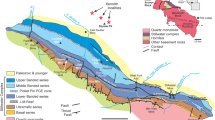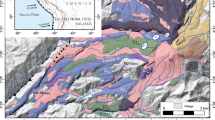Abstract
Mafic dikes and sheets rich in Fe, Ti-oxides and apatite are commonly associated with Proterozoic massif anorthosites and are referred to as oxide-apatite gabbronorites (OAGN). Within the Adirondacks, field evidence indicates that during middle to late stages of anorthositic evolution, these bodies were emplaced as magmas with unspecified liquid-crystal ratios. Sixty whole rock analyses of Adirondack OAGN and related rocks define continuous oxide trends on Harker variation diagrams (SiO2=37–54%). Similar trends exist for Sr, Y, Nb, Zr, and REE and together suggest a common origin via fractional crystallization. A representative parental magma (plagioclase-rich crystal mush) has been chosen from this suite, and successive daughter magmas have been produced by removal of minerals with compositions corresponding to those determined in actual rocks. Least squares, mass balance calculations of major element trends indicate that removal of intermediate plagioclase (∼An40–50) plus lesser amounts of pyroxene account for the compositional variation of this suite and produce very low sums of the squares of the residuals (R2 s>0.25). The extracted mineral phases correspond volumetrically and compositionally to those of the anorthositic suite, and the model succeeds in accounting for the observed OAGN trends. The major element model is utilized to calculate trace elejent concentrations for successive magmas, and these agree closely with observation. We conclude that, beginning with a plagioclase-rich crystal mush, the extraction of intermediate plagioclase (∼An40–50) drives residual magmas to increasingly Fe-, Ti-, and P-rich and SiO2-poor conditions characteristic of Fenner-type fractionation. The crystallization sequence is plagioclase→plagioclase+orthopyroxene→plagioclase+orthopyroxene (pigeonite)+augite. Fe, Ti-oxides begin to crystallize near the end of the sequence and are followed by apatite and fayalitic olivine which appears in place of pigeonite. Augitic pyroxene becomes the dominant ferromagnesian phase in late stages of fractionation. Resultant OAGN magmas are injected into congealed anorthosite by filter pressing of liquid-rich interstitial fractions. Varying compositions of the dikes reflect filter pressing at different stages during fractionation and thereby provide information on the fractionation history of Proterozoic massif anorthosites.
Similar content being viewed by others
References
Ashwal LD (1978) Petrogenesis of massif-type anorthosites: crystallization history and liquid line of descent of the Adirondack and Morin complexes. PhD dissertation, Princeton University
Ashwal LD (1982) Mineralogy of mafic and Fe−Ti oxide-rich differentiates of the Marcy anorthosite massif, Adirondacks, New York. Am Mineral 67: 14–27
Ashwal LD, Seifert K (1980) Rare earth element geochemistry of anorthosite and related rocks from the Adirondacks, New York, and other massif complexes. Geol Soc Am Bull 91: 105–107:659–684
Balk R (1931) Structural geology of Adirondack anorthosite. Min Pett Bd 41: 308–434
Bryan WB (1986) Linked evolutionary data arrays: a logical structure for petrologic modeling of multisource, multiprocess magmatic systems. J Geophys Res 39: 5891–5900
Buddington AF (1939) Adirondack igneous rocks and their metamorphism. Geol Soc Am Mem 7
Buddington AF (1972) Differentiation trends and parental magmas for anorthositic and quartz-mangeritic series, Adirondacks, New York, Geol Soc Am Mem 132: 477–488
Davis BTC (1971) Bedrock geology of the St. Regis quadrangle, New York. NY State Mus Sci Serv Map Chart Ser 16: 34
Emslie RF (1971) Liquidus relations and subsolidus reactions in some plagioclase-bearing systems. Carnegie Inst Washington Yearb 69: 148–155
Emslie RF (1978) Amorthosite massifs, rapakivi granites, and late Precambrian rifting of North America. Precambrian Res 7: 61–68
Emslie RF (1985) Proterozoic anorthosite massifs. In: Tobi A, Touret J (eds) The deep Proterozoic crust of the North Atlantic provinces. NATO Adv Study Inst 158: 139–160
Epler NA (1987) Experimental study of Fe−Ti oxide ores from the Sybille Pit in the Laramie anorthosite, Wyoming. MSc dissertation, State University of New York at Stony Brook
Fram MS, Longhi J (1992) Phase equilibria of dikes associated with Proterozoic anorthosite complexes. Am Mineral 77: 605–616
Frost BR, Lindsley DH (1992) Equilibria among Fe−Ti oxides, pyroxenes, olivines, and quartz: part II. Applications. Am Mineral 77: 1004–1020
Goldberg SA (1984) Geochemical relationships between anorthosite and associated iron-rich rocks, Laramie Range, Wyoming. Contrib Mineral Petrol 87: 376–387
Green TH (1969) High pressure experimental studies on the origin of anorthosite. Can J Earth Sci 6: 427–440
Harrison TM, Watson EB (1984) The behavior of apatite during crustal anatexis: equilibrium and kinetic considerations. Geochim Cosmochim Acta 48: 1467–1477
Henderson P (1982) Inorganic geochemistry. Pergamon, Oxford
Isachsen YW, Moxham RL (1969) Chemical variation in plagioclase megacrysts from two vertical sections in the main Adirondack metanorthosite massif. In: Isachsen Y (ed) Origin of anorthosite and related rocks. NY State Mus Mem 18: 255–2657
Kelly WM (1979) Chemistry and genesis of titaniferous magnetite and related ferromagnesian silicates, Sanford Lake deposits, Tahawus, New York. PhD dissertation, University of Massachusetts-Amherst
Kennedy GC (1955) Some aspects of the role of water in rock melts. Geol Soc Am Spec Pap 62: 489–503
Lindsley DH, Frost R (1992) Equilibria among Fe−Ti oxides, pyroxdenes, olivine, and quartz. Part I: theory. Am Mineral 77: 987–1003
Longhi J, Ashwal LD (1985) Two-stage models for lunar and terrestrial anorthosites: petrogenesis without a magma ocean. J Geophys Res 90: C571-C584
McLelland JM, Chiarenzelli JR (1990) Isotopic constraints on the emplacement age of the Marcy massif, Adirondack Mts., New York. J Geol 98: 161–181
McLelland JM, Whitney PR (1977) The origin of garnet in the anorthosite-charnockite of the Adirondacks. Contrib Mineral Petrol 60: 161–181
McLelland JM, Whitney PR (1990) Anorogenic, bimodal emplacement of anorthositic, charnockitic, and related rocks in the Adirondack Mountains, New York. Geol Soc Am Spec Pap 246: 301–315
Morse SA (1982) A partisan view of Proterozoic anorthosites. Am Mineral 67: 1087–1100
Morse SA, Nolan K (1985) Kiglapait geochemistry VII. Yttrium and rare earth elements. Geochim Cosmochim Acta 49: 1621–1644
Olson KE (1992) The petrology and geochemistry of mafic igneous rocks in the anorthosite-bearing Adirondack Highlands, New York. J Petrol 33: 471–502
Osborn EF (1959) Role of oxygen pressure in the crystallization and differentiation of basaltic magma. Am J Sci 257: 609–647
Owens BE, Dymek RF (1992) Fe−Ti−P-rocks and massif anorthosite: problems of interpretation illustrated from the Labrieville and St-Urbain plutons, Quebec. Can Mineral 30: 163–190
Park CF (1961) A magnetic “flow” in northern Chile. Econ Geol 56: 431–444
Philpotts AR (1966) Origin of anorthosite-mangerite rocks of southern Quebec. J Petrol 7: 1–64
Philpotts AR (1981) A model for the generation of massif-type anorthosites. Can Mineral 19: 233–253
Philpotts J, Schnetzler C (1970) Phenocryst-matrix partition coefficients for K, Rb, Sr, and Ba with applications to anorthosite and basalt genesis. Geochim Cosmochim Acta 34: 307–322
Stephenson RC (1945) Titaniferous magnetite deposits of the Lake Sanford area, New York. NY State Mus Bull 340
Wager LR, Brown GM (1967) Layered igneous rocks. Freeman, San Francisco
Author information
Authors and Affiliations
Rights and permissions
About this article
Cite this article
McLelland, J., Ashwal, L. & Moore, L. Composition and petrogenesis of oxide-, apatite-rich gabbronorites associated with Proterozoic anorthosite massifs: examples from the Adirondack Mountains, New York. Contr. Mineral. and Petrol. 116, 225–238 (1994). https://doi.org/10.1007/BF00310702
Received:
Accepted:
Issue Date:
DOI: https://doi.org/10.1007/BF00310702




